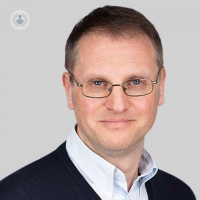Gamma Knife Radiosurgery: your questions answered
Written by:Gamma Knife radiosurgery is a popular option used to treat brain tumours. Leading consultant neurosurgeon Mr John Yianni answers your commonly asked questions about the surgery, including how it works, its advantages over normal brain surgery and the recovery process.

What is Gamma Knife radiosurgery, and how does it work?
Gamma Knife radiosurgery is a non-invasive, highly precise form of radiation therapy primarily used to treat brain conditions such as tumours, vascular malformations, and trigeminal neuralgia. It utilises 192 focused beams of gamma radiation to target and destroy abnormal or diseased tissue within the brain.
This radiation is precisely aimed at the affected area, while sparing the surrounding healthy brain tissue. Gamma knife radiosurgery is typically performed in a single session and doesn't require an incision, making it a minimally invasive option.
What conditions can be treated with Gamma Knife radiosurgery?
Gamma Knife radiosurgery is effective intreating a variety of brain conditions, including the following:
- brain tumours (both cancerous and non-cancerous)
- arteriovenous malformations (AVMs)
- trigeminal neuralgia, and some neurological disorders.
The surgery can also used for specific cases of metastatic brain cancer and functional disorders such as cavernoma. The suitability for treatment is based on a variety of factors, such as the patient's condition and the size, location, and type of the brain abnormality.
What are the advantages of Gamma Knife radiosurgery over traditional brain surgery?
Gamma Knife radiosurgery offers several advantages over traditional open brain surgery. It is non-invasive, meaning it does not require an incision or the removal of the skull. As a result, it typically leads to shorter hospital stays, quicker recovery times, and reduced risk of complications.
Additionally, the precise nature of the treatment minimises damage to healthy brain tissue and often results in fewer side effects.
Is Gamma Knife radiosurgery painful, and what is the recovery process like?
Due to the non-invasive nature of Gamma Knife radiosurgery, it is not painfu, and patients are usually awake during the procedure. Local anaesthesia or mild sedation may be used during the procedure to ensure the patient’s comfort.
Recovery following the procedure is relatively quick, and the majority of patients can resume normal activities within a few days. Patients may experience some mild side effects such as headache or swelling. However, such side effects will typically ease off within a short time.
Are there any potential risks or side effects associated with Gamma Knife radiosurgery?
While Gamma Knife radiosurgery is considered safe and effective, it can pose the risk of some potential side effects, although they are generally mild and short-lived.
The surgery may provoke headaches, nausea, or fatigue. Additionally, there is a small risk of radiation-induced effects that can appear over time. Fortunately, however, the likelihood of such effects taking place is rare.
The specific risks and side effects posed can vary due to the patient's condition and the treatment plan, therefore it is essential to discuss these aspects with your doctor before undergoing the procedure.
If you would like to book a consultation with Mr Yianni, simply visit his Top Doctors profile today.


